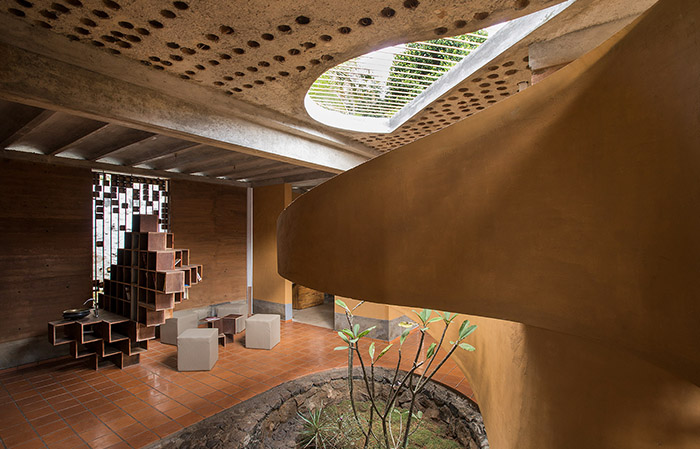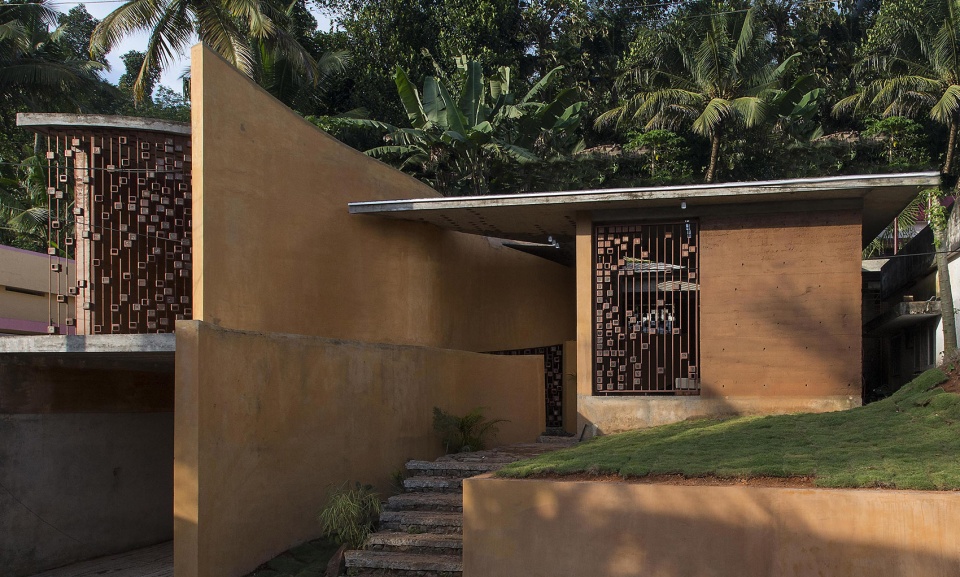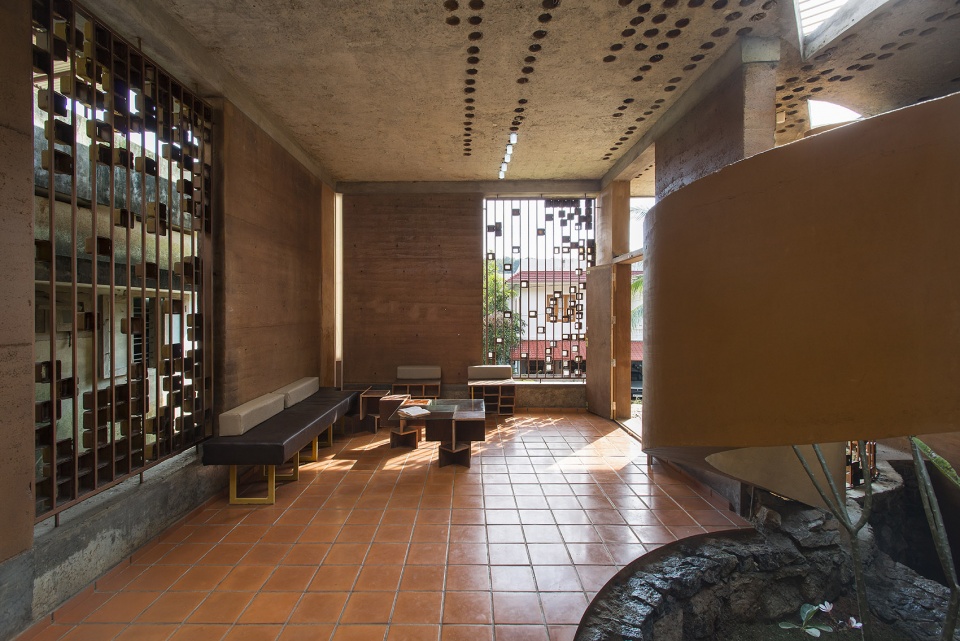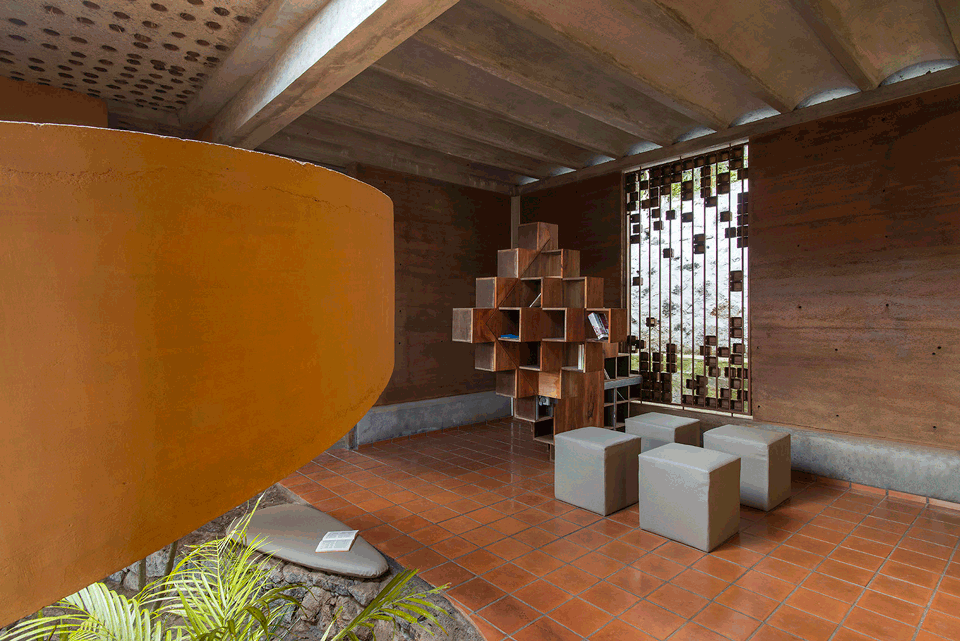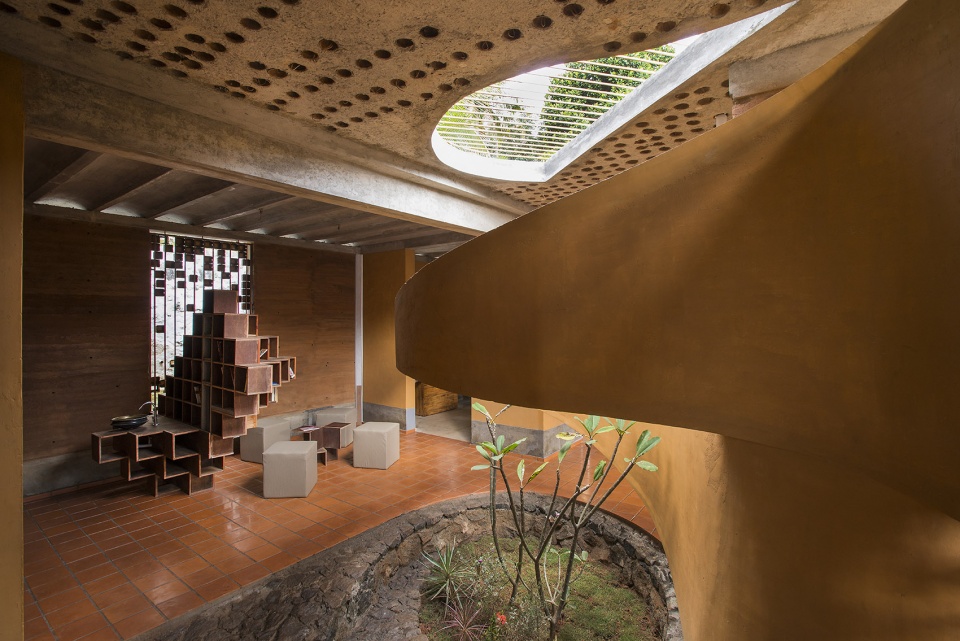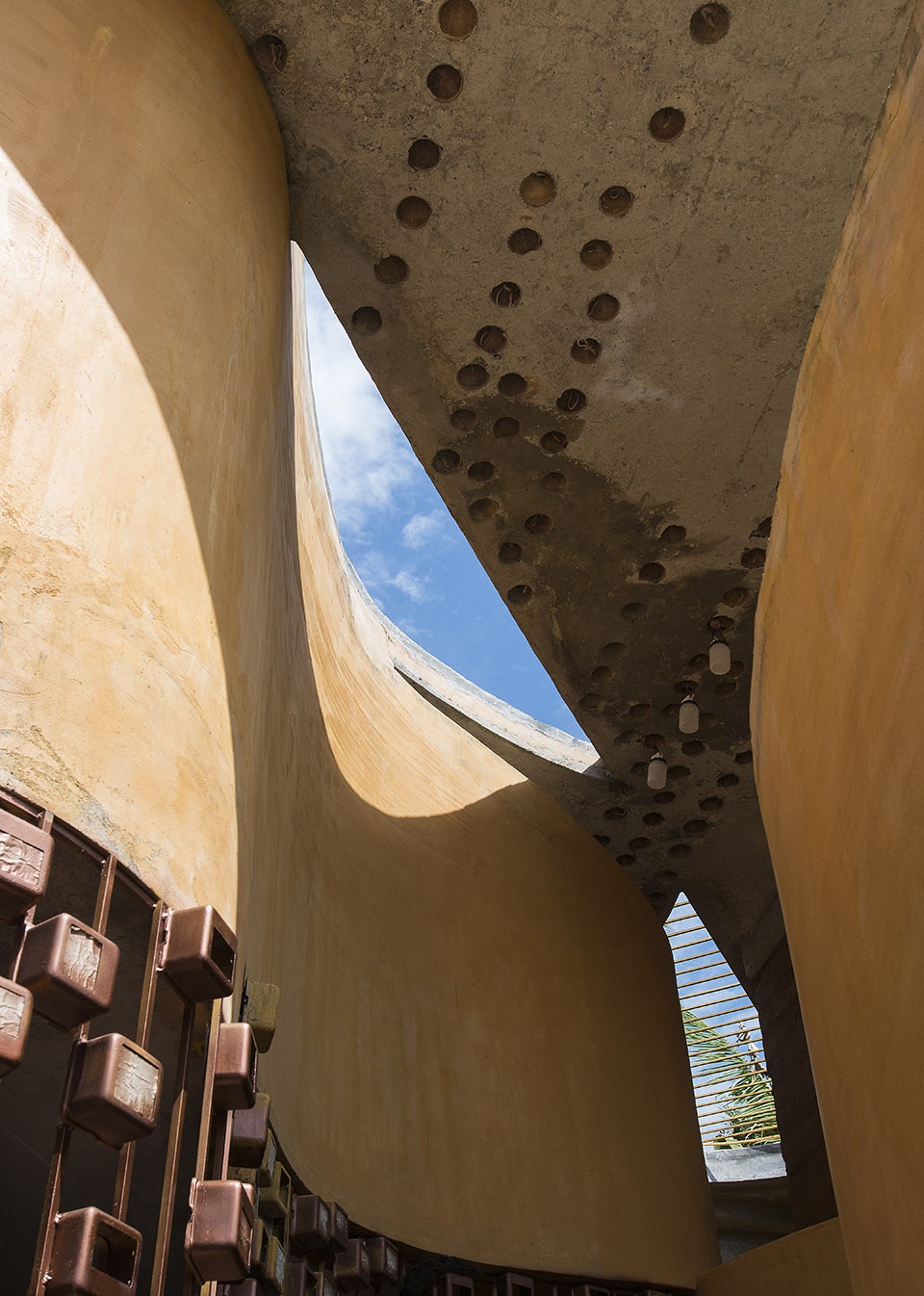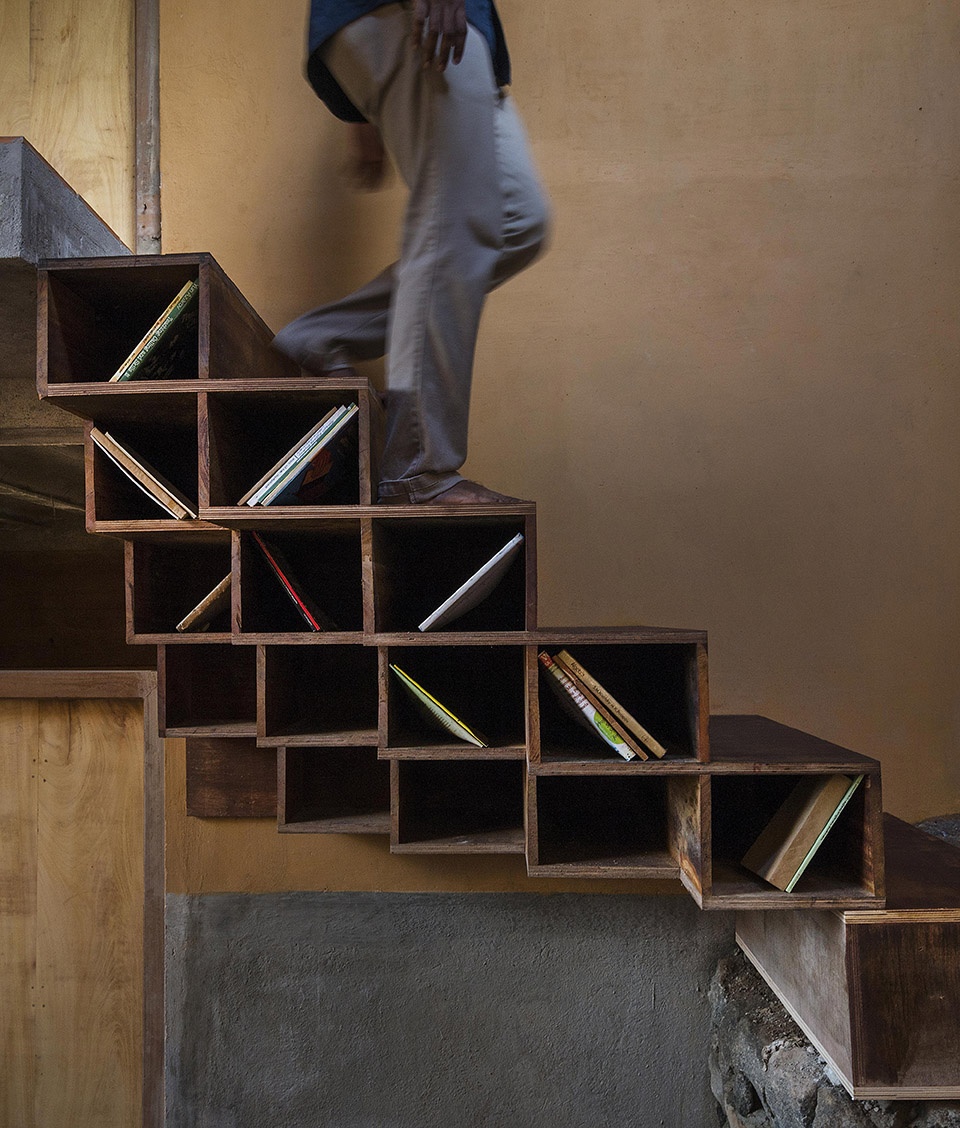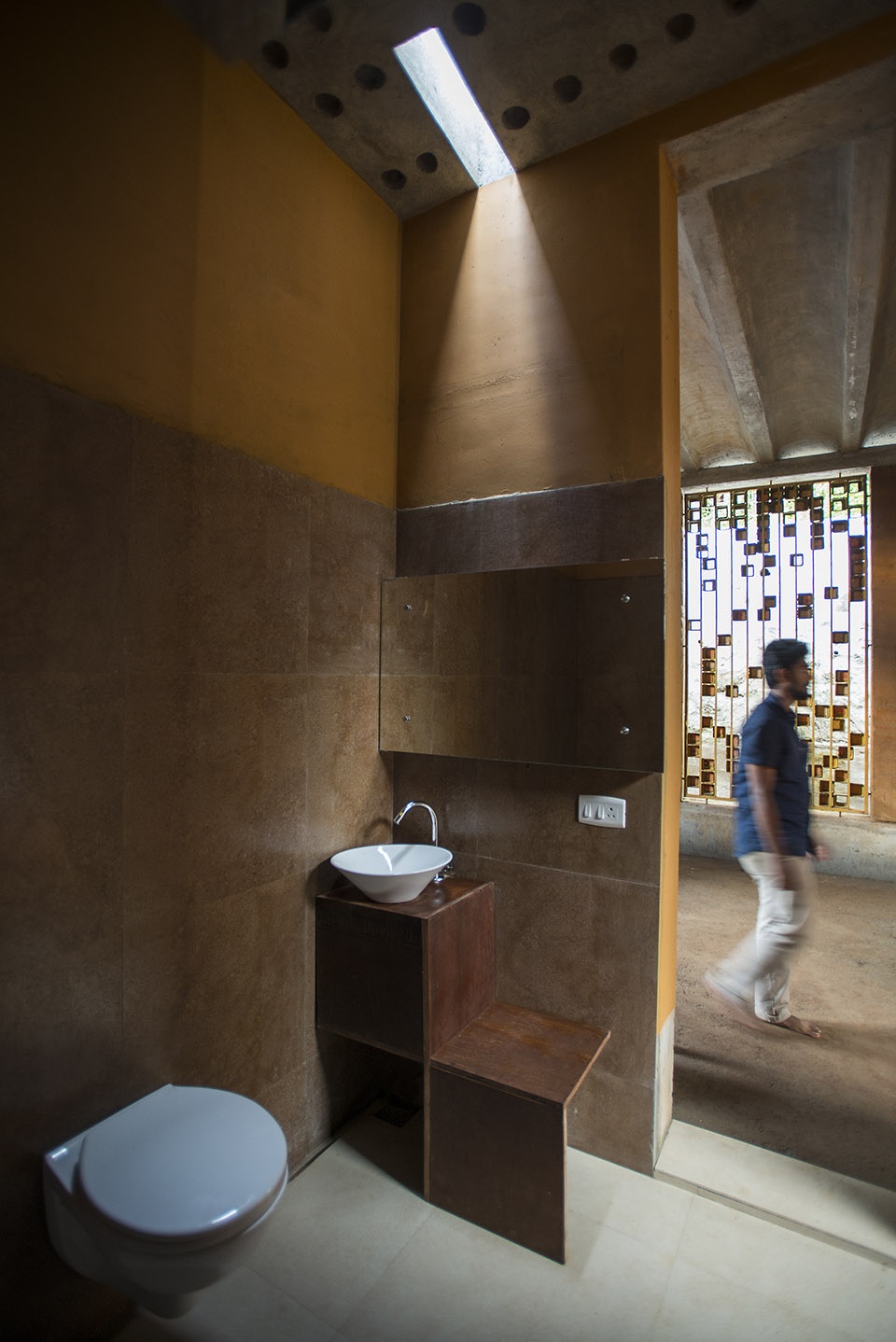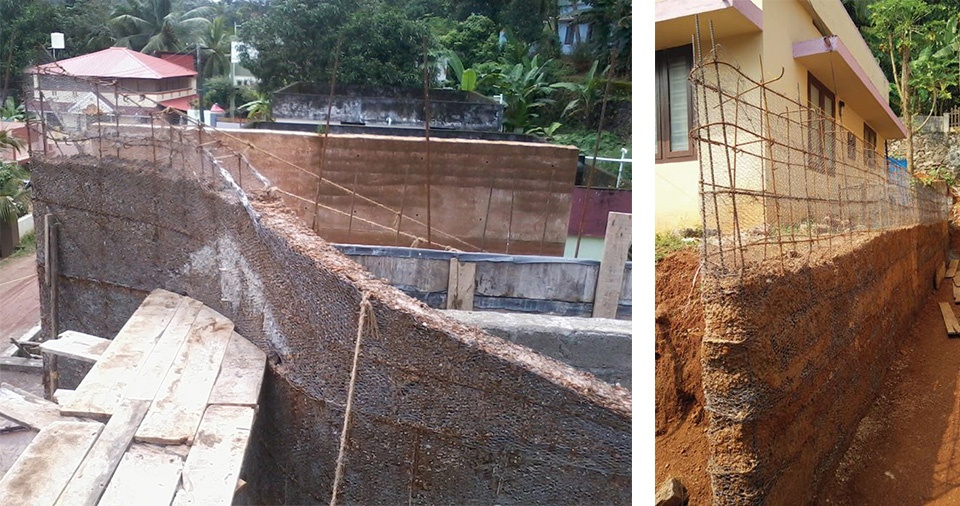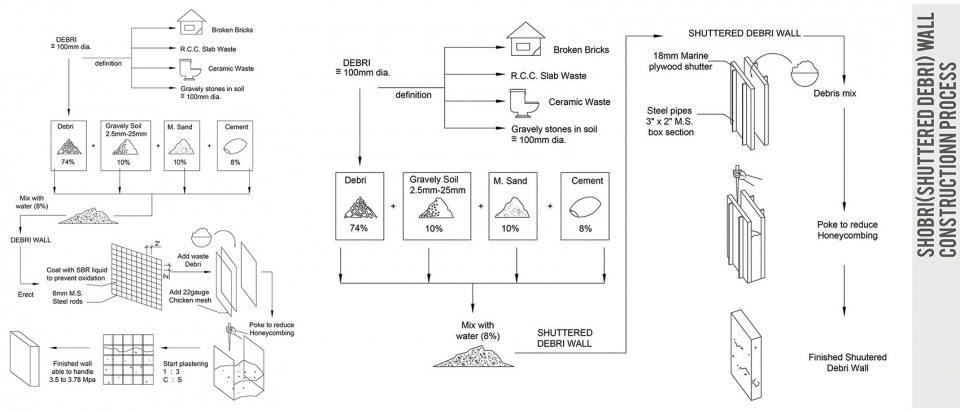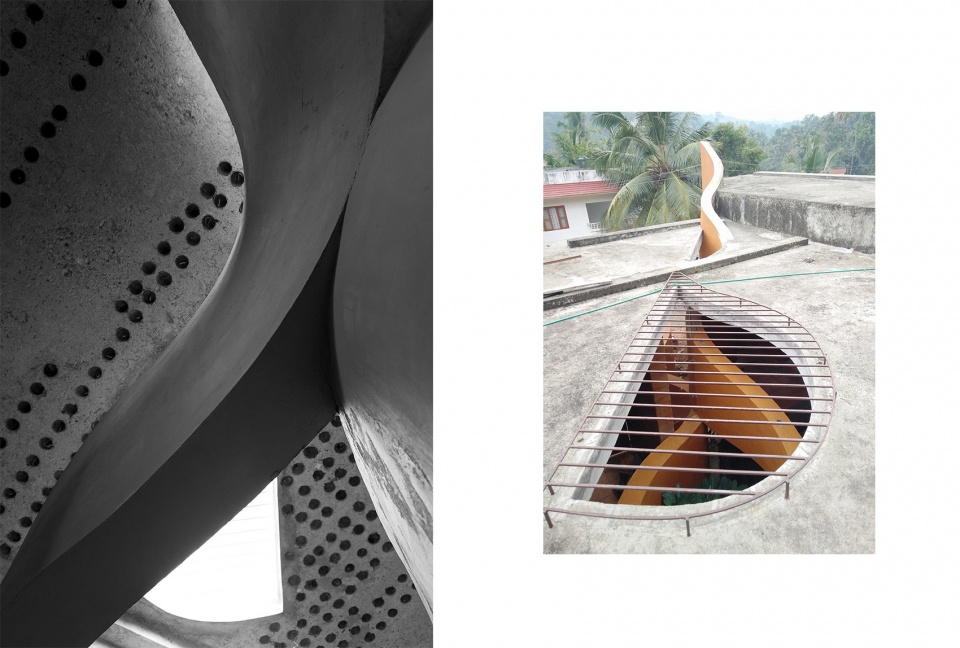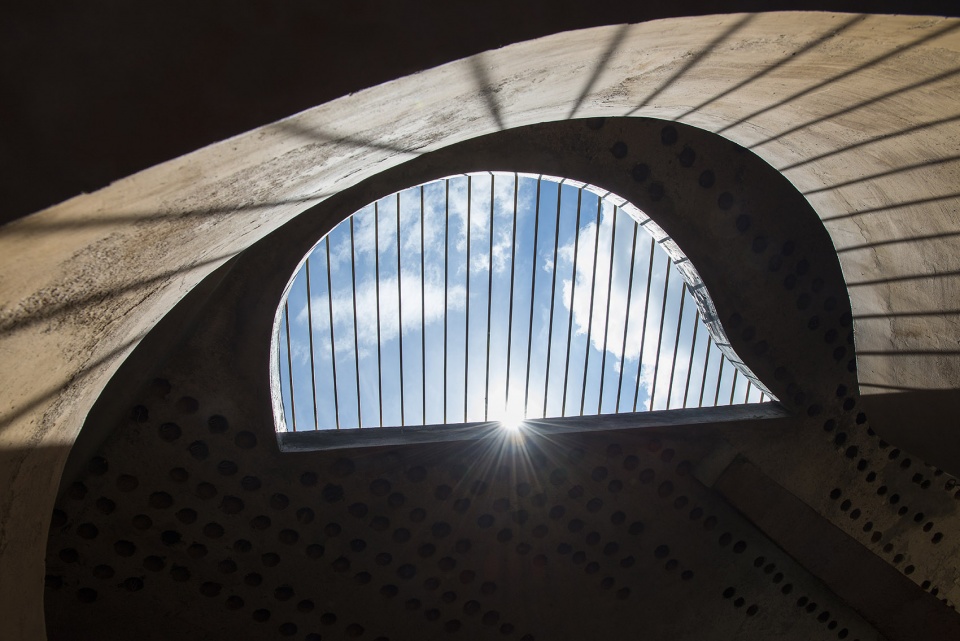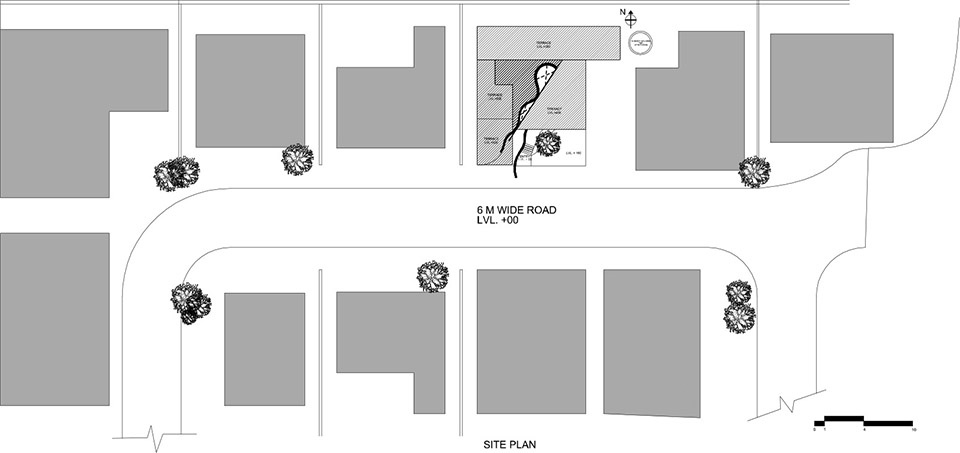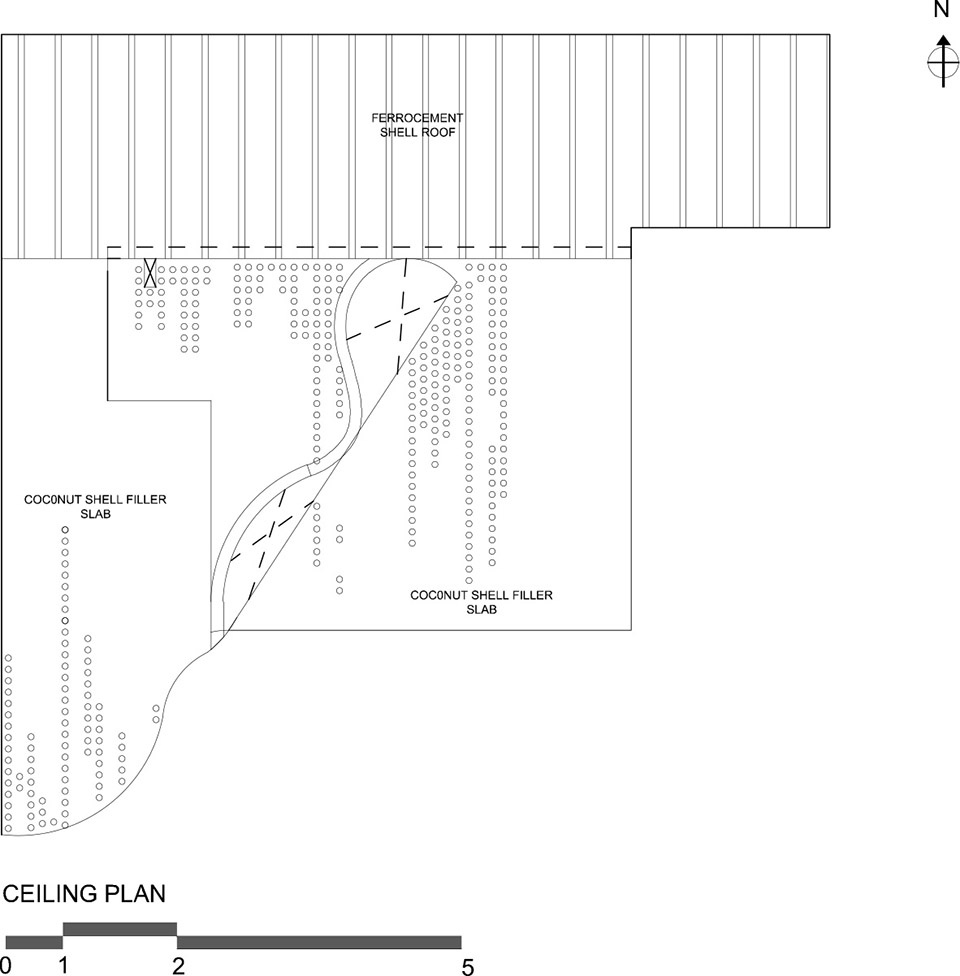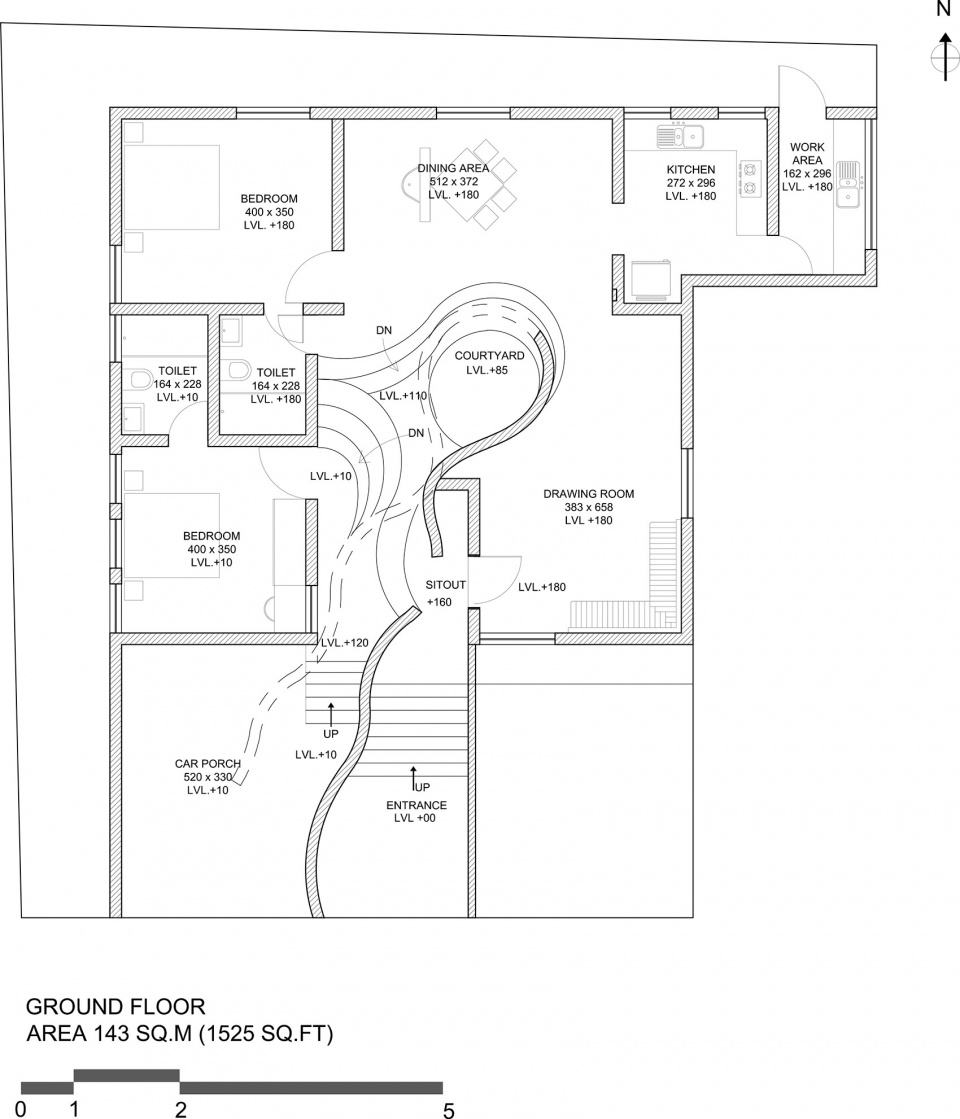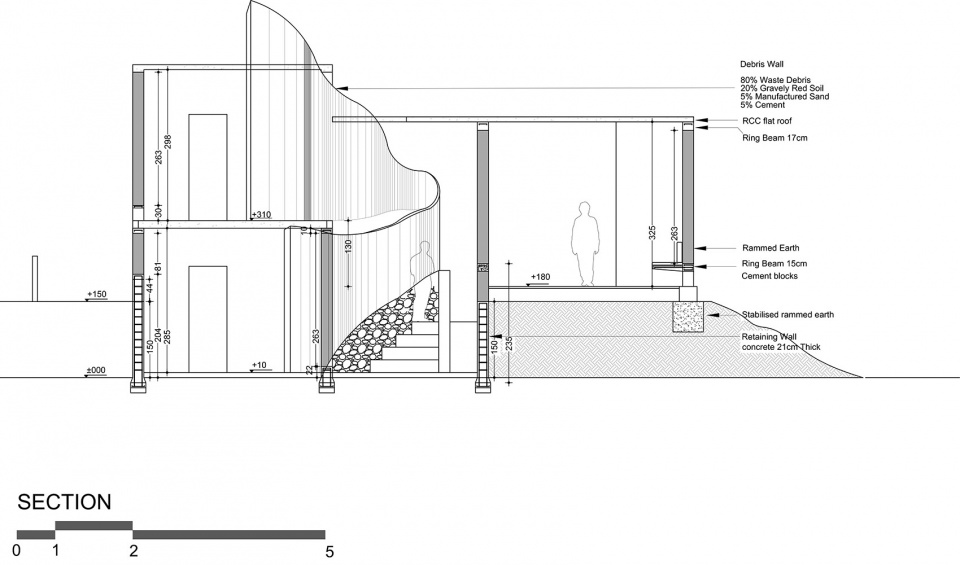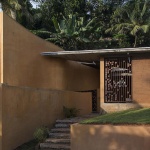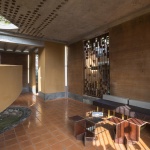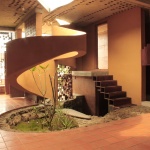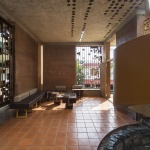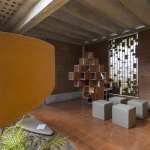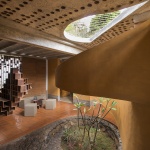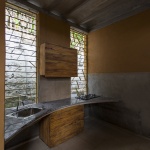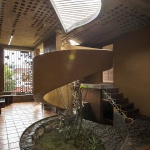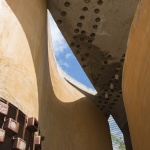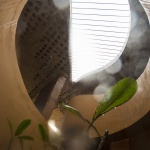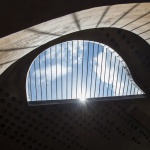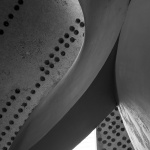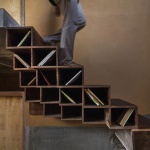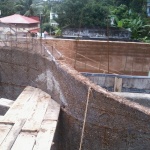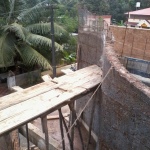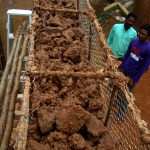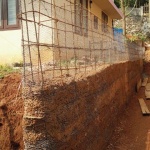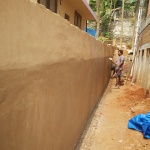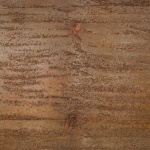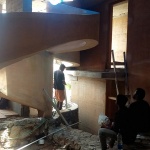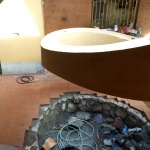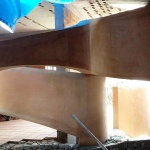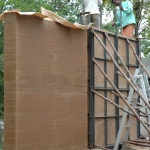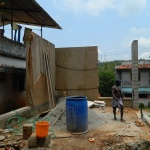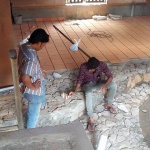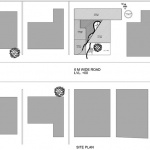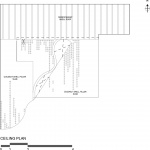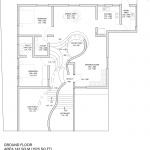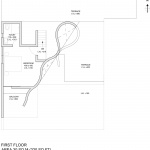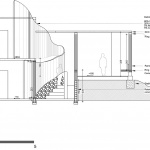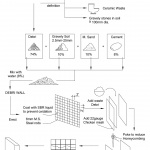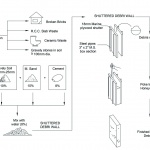感谢 Wallmakers 对gooood的分享。更多关于:Wallmakers on gooood。
Appreciation towards Wallmakers for providing the following description:
这座夯土材质的住宅坐落于一个古朴的小镇,是为一家六口而设计。场地所在的斜坡上残留着许多被拆除的建筑,为了最大程度地利用有限的面积,住宅的体量被设置于多个层级,从而以最可行的方式来满足住户的构想。
Nestled in a quaint township, is this rammed earth residence for a family of six. The site was at a slope with remnants of many demolished buildings. Maximizing the given area the building is set in multiple levels to accommodate the family and to meet the client’s dreams in the most feasible way.
▼建筑主立面,Front view of the building ©Anand Jaju
在城市或者城市边缘打造规划明确的住宅往往拥有多种可能性,然而对于印度正在发展中的郊区居民而言,建造新房可能意味着要花掉毕生积蓄。这样的住宅完全不同于那种周末度假别墅,它们是居住者赖以生存的居所,其本身已经可以看做是一个独立的建筑原型。
There is a lot of potential in dealing with small urban and sub-urban homes for clients who approach architects with limited budgets and elaborate programs. Houses are aspirational investments for many in developing sub-urban landscape of India sometimes demanding a lifetime of savings from the clients. Very different from weekend homes, these houses have become prototypes in themselves and act as pivots for the life of the inhabitants.
▼从入口望向起居空间,View from entrance ©Anand Jaju
▼起居室,Living area ©Anand Jaju
▼餐桌和书架的组合变化,Dining table put up as shelf & dining table brought down ©Anand Jaju
▼从夹层望向首层,View from mezzanine floor ©Anand Jaju
▼主卧室,Master bedroom ©Anand Jaju
这座住宅在建造过程中始终采用了可回收且生态友好的材料,并且突破了材料本身的限制,为建筑赋予了富有表现力的观感。“碎片墙”(由碎料建成的墙壁)由现场回收的材料建成,椰子壳做成的填充板有效降低了混凝土的使用量。各种各样的技术被应用在建筑当中,共同营造出一种奇特而充满趣味的观感。
This house employs recycled and eco-sensitive materials in its making with much care all the while ensuring that the material limitations are overcome and an expressive architecture is allowed to emerge from the constraints. The Debris wall is built over a discovered foundation and with materials that are recycled from the site. The coconut shell filler slab enables the architect to reduce concrete in the same. While the house uses numerous alternate technologies, there is a certain whimsy and playfulness in its design.
▼弯曲的“碎片墙”,Front wavy wall
小型庭院确保了建筑的自然通风,由废料制成的窗户保持了精致的细节。内部空间的连接顺应了场地的层次关系,并且与周围环境在尺度上建立了和谐的关系。
The small court ensures ventilation and the windows made from scrap but with a certain careful detailing. The levels of the site are explored for connections within and the house maintains a scale with sensitivity towards the neighbourhood.
▼中央庭院,Central courtyard ©Anand Jaju
随着城市化进程的蔓延,越来越多的乡镇住宅偏向于使用玻璃、混凝土、钢材等具有城市特征的材料。该项目反其道而行,利用传统材料为建筑赋予了另一种“现代感”,通过对特定场地条件的回应,让城镇住宅找到了属于它们自己的独特语言。
As urban influence spreads in smaller towns, many aspire for homes that often mimic the city with use of glass, concrete, steel and other urban materials that dominate the imagery. By resisting this omnipresent phenomenon and generating an architecture that is modern and yet, responsive to the specific conditions of its context will perhaps enable the towns to find their unique language.
▼厨房,Kitchen ©Anand Jaju
建筑中的材料是基于当地环境特征和经济条件而精心选择的。墙壁的泥土是从场地中挖掘而来,既有建筑的残骸转变为一扇弧形的墙壁(即碎片墙),并在中央围合出一个庭院,作为房屋的焦点。
Considering the local nuances and the economic constraints, the materials were responsibly chosen; the walls rose out from the earth that was dug out within the site, the debris from the earlier building is turned to a curvilinear wall that forms the central courtyard and becomes the central focus of the house which is called the Debris Wall and is also the advent of a new technology.
▼庭院仰视,Open to sky courtyard ©Anand Jaju
室内家具也使用了回收的木材,主要用于存放房屋主人的教学书籍。环保举措包括雨水收集和再循环系统,以及基于布局精确的庭院和立面而实现的被动式通风。从废品场回收而来的电表箱被运用到窗户格栅上,椰子壳被用于混凝土屋顶的填充;后半部分的体量覆盖以钢丝网水泥壳屋顶。整个建筑基于场地的变化应运而生,以低调的姿态坚守了其对于社会和环境的责任。
Recycled wood is used to create the furniture which derives it form from boxes to store lots of books for the client who is a school teacher. Further green initiatives include a rainwater harvesting and recycling system and a responsive passive air circulation achieved through the careful planning of the courtyard and the facades. The windows protected with meter boxes from a local scrapyard create a mural on the rammed earth walls as the day goes by. Coconut shells used as fillers in the concrete roof give a contemporary touch to the structure. The latter half of the house incorporates Ferrocement shell roofs. Looking at the local context, the project strikes out, humbly maintaining its commitment to the society and the environment.
▼回收的木材被做成楼梯兼储物空间,Staircase & utility rack made of recycled wood ©Anand Jaju
▼洗手间,Toilet ©Anand Jaju
“碎片墙”由钢筋网(钢条直径为6mm,分布间距为2英尺)包覆的碎料(含有10%的砾石、5%的水泥以及5%的人造沙)制成。与烧结的砖墙相比,碎片墙消耗的能量要降低5倍(分别为850 MJ/m3和4,501.25 MJ/m3),污染程度要降低4倍(分别为110.11 Kg of CO2 /m3和444.12 Kg of CO2 /m3)。
Using meshed (22 gauge chicken mesh )casing reinforced with 6mm bars at 2 feet intervals vertically and horizontally, lump sized Debris added with 10% gravel and 5% cement and 5%manufactured sand with water was slightly tamped in 2cm layers to form the set of walls defining the entrance.
▼碎片墙施工照片,Central Debris Wall ©Wallmakers
INITIAL EMBODIED ENERGY: Debris walls consume 5 times less energy than a fired brick wall: Embodied energy of Debris wall = 850 MJ/m3;Country fired brick Wall = 4,501.25 MJ/m3
CARBON FOOTPRINT:Rammed earth walls are polluting 4 times less than country fired brick walls: Carbon footprint of Rammed earth wall cement = 110.11 Kg of CO2 /m3;Country fired brick wall = 444.12 Kg of CO2 /m3
▼碎片墙建造流程图,Flowchart of Shuttered Debris Wall ©Anand Jaju
屋顶由预制的钢丝网水泥拱形壳体构成,被手动吊起并放置在正确位置。屋顶的有效厚度为1.5cm,其强度高达1200 kg/m2,有着与钢筋混凝土楼板相同的荷载能力,同时降低了40%的水泥消耗量和30%的钢材消耗量。
Roof is made of precast ferrocement shells lifted and placed in position manually. These wafer-like structures are steel reinforced arched shells with effective thickness of 1.5cm and they take equal load of respective R.C.C slabs. They effectively reduce the overall cement consumption by 40% and steel consumption by 30%.These replace the R.C.C Slab in roofing as they are as strong as 1200 kg/m2
▼从庭院望向屋顶(左);屋顶建造过程(右)Open to sky courtyard (left); roof construction process (right) ©Anand Jaju + Wallmakers
▼从庭院望向屋顶,open to sky courtyard ©Anand Jaju
▼场地平面图,site plan ©Wallmakers
▼屋顶平面图,ceiling plan ©Wallmakers
▼剖面图,section ©Wallmakers
Project name: Debris House – Residence for Mr. Biju Mathew
Architect’s Firm: Wallmakers
Website: www.wallmakers.org
Contact e-mail: www.vinudaniel@gmail.com
Project location: St.Peter’s Junction, Patanamthitta, Kerala
https://goo.gl/maps/1pBjSBfe2Wy
Completion Year: 2015
Gross Built Area (square meters or square foot): 194 sq m
Lead Architects: Vinu Daniel
Archana Nambiar, Jinsy Ann Rajan, Shobitha Jacob, Melvin Davis, Vijith, Abdul Aseeb, Sagar Kudtarkar, Dawal Dasari, Suhaas, Shekkizar, Srivarshini JM
Other participants
(eg. collaborators, clients, consultants, etc):
Masonry contractors:
P.S. Suresh – Shivranjini Constructions, Pondicherry
Fabrication team:
Kunjumon James -J.K steels
Mep:
Unni Krishnan
Sajith Lal
Photo credits: Anand Jaju
Photographer’s website: anandjaju.in
More:Wallmakers 。更多关于:Wallmakers on gooood
